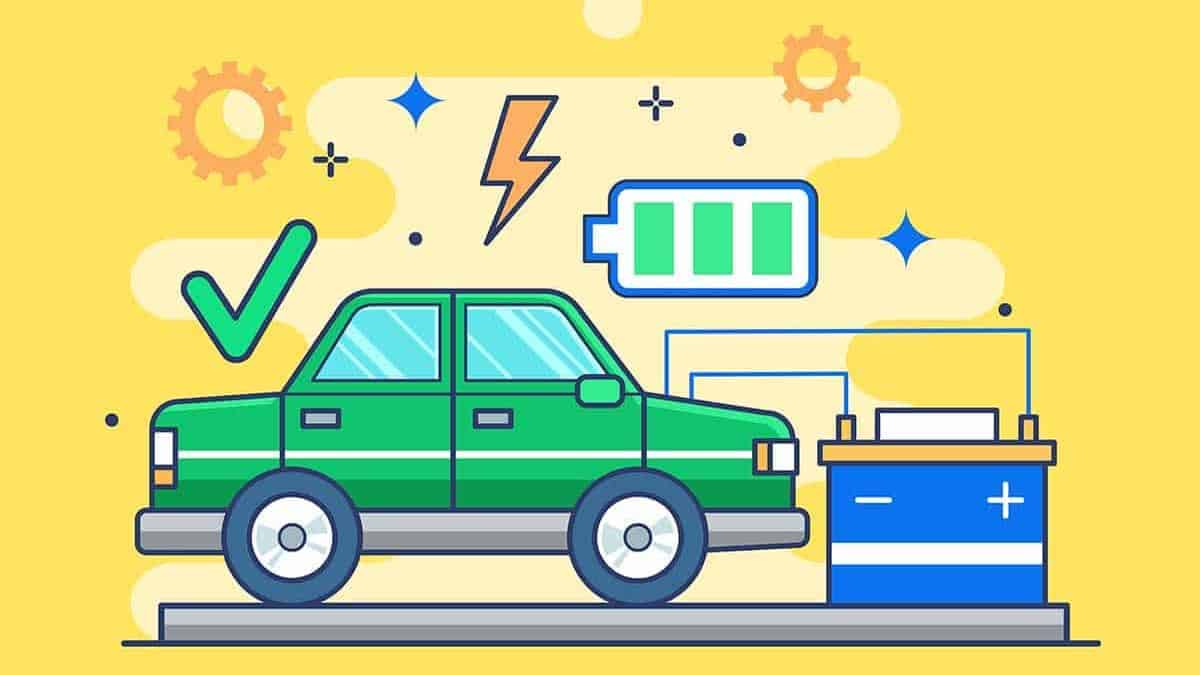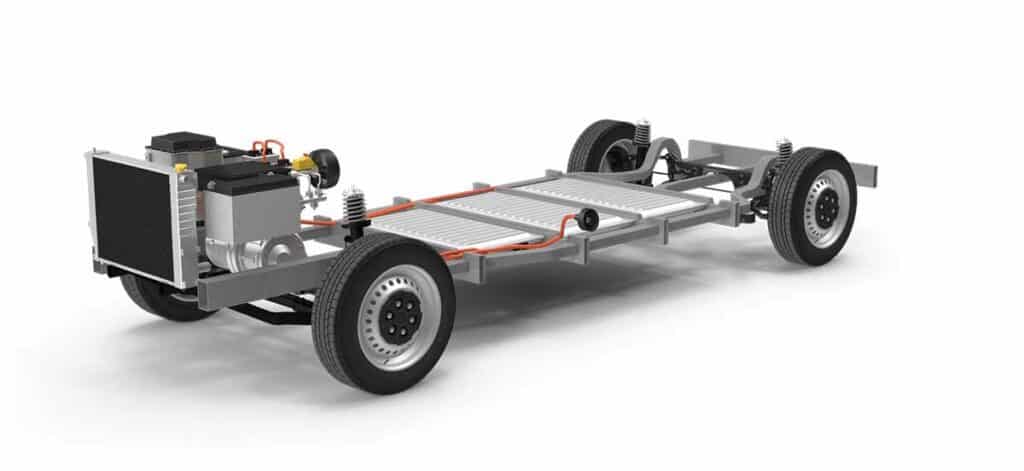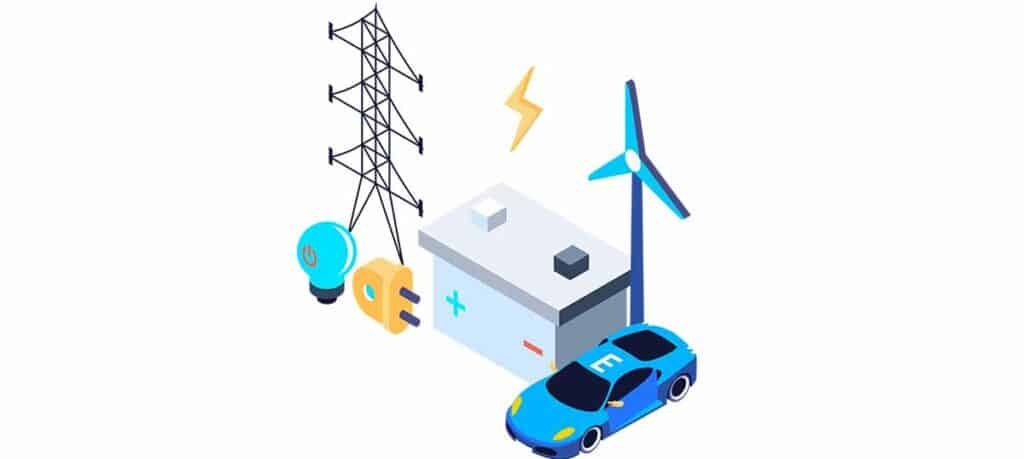Electric vehicles use at least one electric motor to convert electrical energy to kinetic energy. Since mechanical energy can be converted to electric energy, you may wonder if the kinetic energy of each rotating wheel or any motor can provide electric power to the battery pack.
Electric cars can’t charge themselves because they don’t have alternators or generators to convert the kinetic energy of a rotating wheel or rotors to electrical energy. Besides, mechanical energy in motion is converted to heat energy, so there’s nothing to harness.
Any car’s battery needs a power source to charge, which can be the kinetic energy of a rotating wheel converted to electric energy by an electrical generator. But that can only happen in an isolated environment, not when you drive electric vehicles on the road. Read on to know more.

This Is Why Electric Cars Can’t Charge As They Drive
There are different types of electric cars, so whether or not one can charge as it drives depends on the variant. Electric vehicles powered by only a battery pack can’t charge as they drive yet.
Such electric vehicles are also referred to as the following:
- All-electric vehicle
- Battery electric vehicle (BEV)
- Fully electric vehicle
- Only-electric vehicle
- Pure electric vehicle
Many electric vehicles, such as plug-in hybrid and self-charging cars, can charge partially or fully. Also, solar panels and wind turbines can enable BEVs, all-electric vehicles, and hybrid cars to charge while driving, but those are yet to be a reality.
Let me elaborate on the main reasons why BEVs or electric vehicles can’t charge as they drive:
- According to the first law of thermodynamics and the law of energy conservation, you can’t create or destroy energy. You can only convert, store, or transfer energy from one form or system to another.
- According to the second law of thermodynamics, heat energy will transfer from a hot object to its colder surroundings. The same law states that more energy is lost by converting one form into another through irreversible processes.
These fundamental principles combined are the first set of reasons why electric vehicles can’t charge as they drive. Plus, battery electric vehicles don’t operate in an isolated system or have the equipment onboard to generate electrical energy.
When you drive an electric car, the electric motor uses the electrical energy from the battery pack to generate mechanical energy. This kinetic energy is used to operate the axle, the motor’s rotor, and other parts of the car for each rotating wheel.
The operating components and the tires’ friction on the road generates heat.
Thus, the electrical energy of the car’s battery gets converted to kinetic energy, which is subsequently converted to heat energy. You need a system to convert this heat energy to electric energy to charge the car.
That’s the only way electric cars can charge as they drive.
The other imaginable instance is an isolated system that doesn’t lose the resulting heat energy to the environment. Such a scenario can transform electric cars into a perpetual motion machine, which obviously doesn’t exist.
Using an electrical generator to convert kinetic energy to electric energy for the car’s battery is a non-starter.
You will only route the electric power of a battery pack back to the cells after losing substantial energy when you convert it at least twice in the process. Using DC converters, rectifiers, and other essential components, you will also lose energy to charge a car’s battery.
Hybrid Vehicles Can Charge As They Drive and Brake
Annual electric car sales have increased impressively over the past decade, so almost everyone wonders if electric vehicles are the future. Many governments worldwide plan to gradually ban or phase out conventional cars with an internal combustion engine using fossil fuels.
While there are many reasons why you should get an electric car, how many miles such battery-powered vehicles can go still make millions of people weigh their options. This is mostly due to the limited and still developing network of public charging stations compared to diesel/gasoline.
That concern is also probably the main reason we are discussing whether all-electric cars can or cannot charge themselves. While BEVs can’t, hybrid vehicles can charge to some extent as they drive.
Plus, all-electric vehicles can charge when they brake and come to a halt.

Electric Cars Can Partially Charge With Regenerative Braking
Electric cars of many brands, including BEVs and hybrid vehicles, can harness some electrical energy with regenerative braking, such as the following:
- BMW
- Ford
- Honda
- Nissan
- Tesla
- Toyota
Regenerative braking converts the available kinetic energy into electric energy when you step on the brake pedal. Whenever you press the brake pedal, the electric motor no longer runs the wheels.
Instead, every rotating wheel turns the rotors of the electric motors.
This mechanical energy in motion during deceleration requires no electric power from the battery pack. So, any electric vehicle with a regenerative braking system can convert a substantial portion of the kinetic or mechanical energy to electrical energy.
The Tesla Roadster claimed it regained ~64% of electrical energy discharged by the battery pack with regenerative braking. That was a decade and a half ago, and regenerative braking is much more evolved today.
However, the quantum of charge regained will vary for brands and BEVs.
Regenerative braking isn’t of much value on freeways and highways, but city roads and urban areas with traffic jams can deliver enough charge, as you are likely to step on the brake pedal frequently.
The gain may add a few miles and increase the range by a short distance.
Hybrid Self-Charging Cars Can Charge Fully As They Drive
A self-charging hybrid vehicle isn’t an all-electric car, while a self-charging vehicle may not be a plug-in hybrid electric car. Such self-charging cars may only charge the battery pack when you drive, just like a diesel car with an internal combustion engine recharging the auxiliary battery.
Brands like Lexus and Toyota have self-charging cars that can fully charge the car’s battery as you drive. These hybrid cars don’t require you to plug in to charge the battery pack, so you don’t have to search for a charging point en route or need one at home.
Such hybrid cars use the same fundamental concept as old-school alternators.
The diesel car and its internal combustion engine work like an old-school generator using fossil fuels to convert energy. The conventional alternator in traditional cars has been doing this for decades.
Self-charging cars have already surpassed the popularity of every diesel car in Europe. Sales of hybrid cars have also hit record highs in the U.S., but not every model is a self-charging vehicle.
A self-charging vehicle may be a plug-in hybrid.
Plug-In Hybrid Cars Can Self-Charge Partially While Driving
Many plug-in hybrid cars can charge themselves when you drive using their internal combustion engines. So, you can gain some electrical energy for the car’s battery pack from electric motors and an increase in range, probably a short distance, with regenerative braking.
Both plug-in hybrid vehicles and self-charging cars that you cannot plug into a charging point or power source use electric motors, so they can feature regenerative braking if the brands include such tech in the specs for their various models.
However, unlike hybrid vehicles or self-charging cars, a gasoline or diesel car with an electric motor and transmission that you can plug into a charging station at home or public charging stations is unlikely to fully recharge the car’s battery.
A plug-in hybrid electric vehicle’s battery pack may be designed to work with a charging point having the following nominal voltages:
- 110V/120V
- 220V/240V
- 400V/480V
- 800V, etc.
Charging such plug-in hybrid electric vehicles using the kinetic energy of a gasoline or diesel car with an internal combustion engine may not generate much electric power due to unavoidable losses through DC converters, rectifiers, or voltage amplification, among other processes.
However, the battery pack of plug-in hybrid electric vehicles may still gain enough charge to add a short distance to your range, which can be critical if you are a few miles from a charging point.
A self-charging hybrid vehicle that you can plug into a charging point, which may also gain a full charge from its internal combustion engine, is definitely a more self-reliant car. Plus, such hybrid cars with at least one electric motor can gain more electric power through regenerative braking.

Solar-Powered Electric Cars May Charge Fully in the Future
Electric vehicles with solar panels may charge themselves fully in the future, provided the tech advances to the extent that a system can generate enough electrical energy. Most portable or relatively smaller solar panels are usually rated 100 watts, which is insufficient for many electric vehicles available today, including plug-in hybrid and self-charging cars.
A plug-in hybrid with a 50 kWh battery pack will take ~500 hours with a 100 W solar panel for a single charge. That’s almost 62.5 days with 8 hours of peak sun hours, which is unlikely in many parts of the country.
Besides, solar panels aren’t 100% efficient, whether 100 W or others.
Let’s not even talk about a car’s battery with a 100 kWh capacity because it may take an exceedingly long time for a full charge. Plus, no solar-powered electric vehicle is likely to have an ideal angle of incidence when driving or while parked throughout the day.
The future is unknown, though.
Another alternative is using wind turbines to generate electrical energy when you drive electric vehicles. But such technology hasn’t been tested for all-electric, plug-in hybrid, or self-charging vehicles, so one can’t even hazard a guess to foretell the future for wind turbines in this context.
Wireless Charging May Charge Electric Cars As They Drive
A Cornell University associate professor of electrical and computer engineering, Khurram Afridi, is working to develop a concept that may facilitate wireless charging for fully electric vehicles, plug-in hybrids, and self-charging cars on the road with dedicated lanes.
Such a system requires an enormous infrastructural overhaul if the concept actually works on a large scale. If wireless charging is viable for electric vehicles as they drive, it can be a great way to make self-charging cars a reality sooner than later.
A plug-in hybrid or solar-powered electric car with wind turbines may take a long time to become a reality. Wireless charging may provide enough charge on the road, whether driving or parked, and an electric car’s battery may gain a full charge on dedicated lanes of freeways and highways.
Regardless of such possibilities, electric cars can’t be a perpetual motion machine. Even if you have the most advanced self-charging vehicle or a powerful solar-powered electric car, you are still relying on a power source, without which you won’t be able to run the electric motor.
Conclusion
Electric vehicles can’t charge themselves without a sufficient power source, such as a diesel car with an internal combustion engine, a few solar panels on a solar-powered electric car, and/or wind turbines. Plug-in hybrid and self-charging cars can charge the battery pack to an extent.
- Tesla Charger Installation Cost (Home Setups) - March 1, 2024
- Tesla Phone Key Disconnected (Troubleshooting Guide and Quick Fixes) - March 1, 2024
- Tesla FSD 12 (Explained) - March 1, 2024